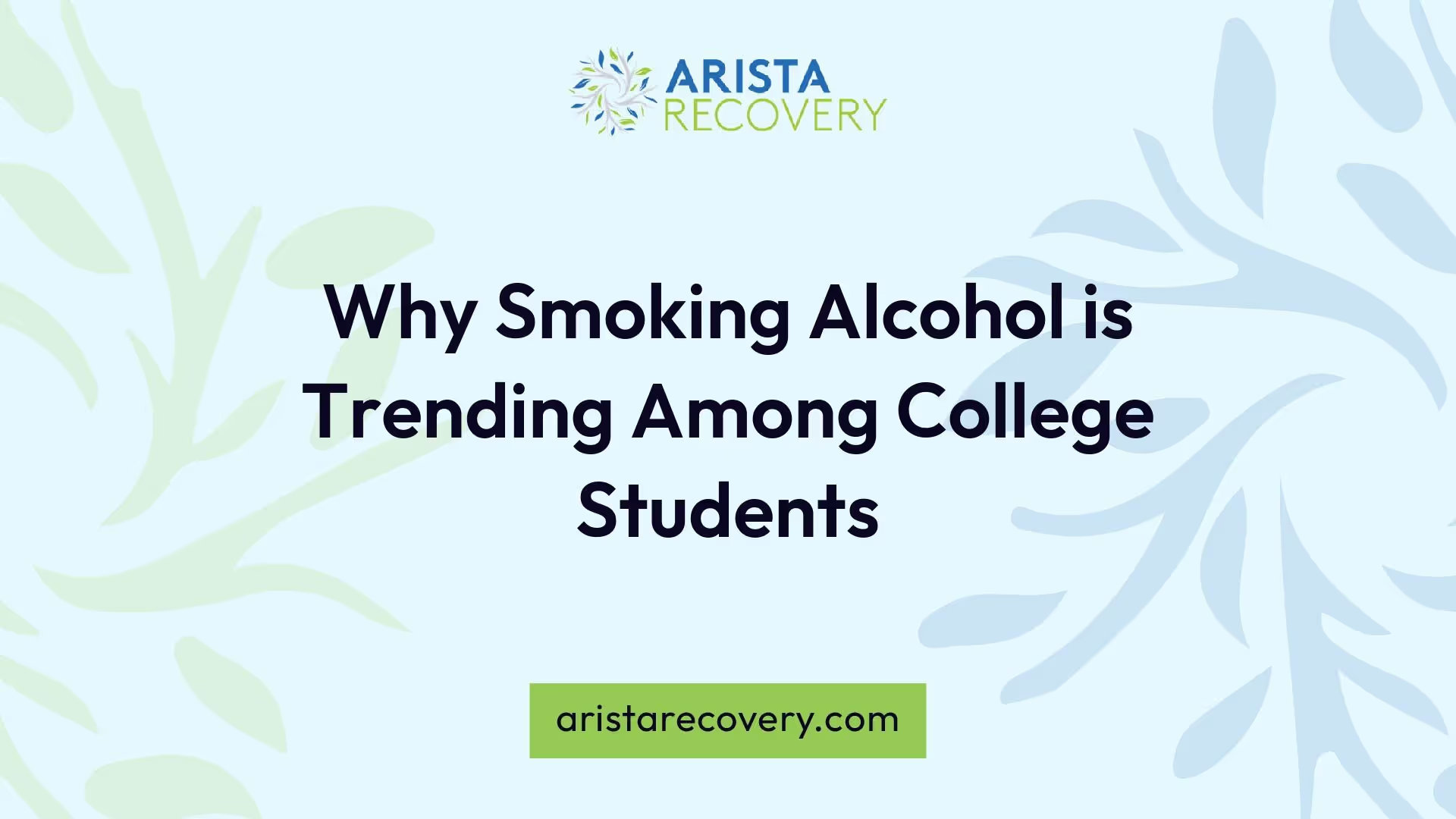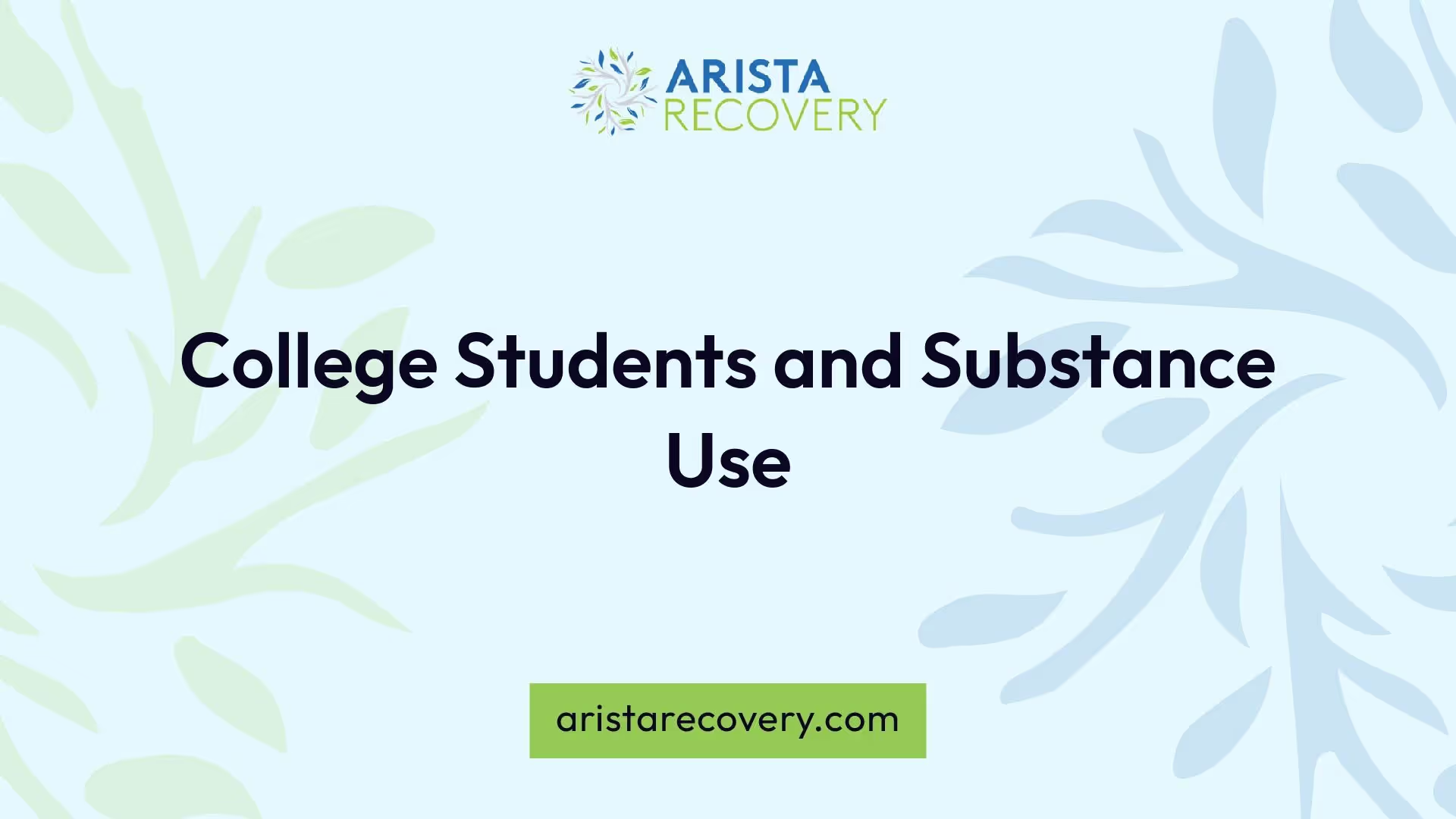Why Smoking Alcohol is Trending Among College Students

The Trend of Smoking Alcohol
The trend of smoking alcohol, particularly among college students, is gaining attention for its quick intoxicating effects and perceived novelty. This practice involves heating alcohol to produce vapor or aerosols, which can be inhaled. Although it may seem appealing due to its efficiency, it carries significant health risks.

Co-occurrence of Smoking and Drinking
The co-occurrence of smoking and drinking is prevalent among college students. Studies have shown that 44.3% of drinking occasions involve simultaneous smoking, suggesting a strong link between the two behaviors (NCBI). College student smokers tend to engage in heavier drinking patterns, including:
BehaviorSmokersNon-smokersAmount of Alcohol Consumed per OccasionHigherLowerFrequency of DrinkingMore FrequentLess FrequentAlcohol-related ProblemsMore IssuesFewer Issues
This relationship indicates that those who smoke are likely to drink more alcohol and face a greater risk of alcohol-related complications.
Health Risks of Smoking Alcohol
Smoking alcohol poses various health risks that differ from traditional drinking. The process of inhaling alcohol vapor results in rapid intoxication, leading to intense effects that can be alluring to young adults. However, this method is dangerous.
The inhalation of alcohol vapor activates specific brain regions related to addictive behaviors, heightening concerns regarding the potential for addiction. This is particularly problematic for teens, whose brains are still developing crucial areas responsible for impulse control and risk assessment.
Additionally, this trend has seen a resurgence of DIY methods for smoking alcohol, reminiscent of earlier devices like AWOL (alcohol without liquid), which faced prohibition in the United States. Techniques such as pouring alcohol over dry ice to create vapors are becoming more common. This practice risks not only addiction but also a range of immediate health consequences, including potential alcohol poisoning.
Overall, the emerging trend of smoking alcohol among college students highlights the complexities and dangers associated with combining smoking and drinking behaviors.
College Students and Substance Use

Alcohol and Tobacco Trends
The connection between alcohol consumption and tobacco use among college students is evident in various studies. Approximately 44.3% of all drinking occasions among these students involve smoking (NCBI). This co-occurrence leads to increased consumption habits, with smoking students reporting higher incidents of alcohol use. For instance, college student smokers drink significantly more per occasion, as well as more frequently, compared to their non-smoking peers. They also experience a greater number of alcohol-related problems.
BehaviorStudent SmokersNon-Smoking DrinkersAverage drinks per occasionHigherLowerFrequency of drinkingMore oftenLess oftenAlcohol-related issuesMore prevalentLess prevalent
The data illustrates a concerning trend where smoking and drinking behaviors are closely linked, highlighting the need for awareness among college students about the risks involved.
College Student Portrayal
In 2008, nearly 71 million Americans aged 12 and older had used a tobacco product within the month prior to being surveyed. Among college students, the smoking prevalence was found to be 23.5% across ten public colleges in Virginia. The study revealed that smokers are more likely to be white, female, and often report lower life satisfaction and grade point averages compared to non-smokers (Wellbrook Recovery).
The emergence of electronic cigarettes and vaporizer devices has significantly changed the landscape of substance use on college campuses. These devices have surged in popularity, contrasting sharply with the overall decline in traditional tobacco use observed over the past two decades. Innovatively designed devices, such as the Juul, deliver concentrated nicotine levels, leading to potential nicotine dependence among students. Furthermore, these devices facilitate discreet consumption of nicotine and cannabis oil, thereby contributing to the growing trend of substance use among college populations.
Overall, the patterns of alcohol and tobacco use among college students are complex and warrant further investigation into their implications for health and well-being.
Risks and Dangers of Smoking Alcohol
Smoking alcohol has emerged as a concerning trend, especially among college students. This method of consuming alcohol carries significant risks and dangers which individuals need to be aware of.
Immediate Effects of Inhaling Alcohol
Vaping or smoking alcohol involves heating alcohol or pouring it over dry ice to create vapors, which are then inhaled. This practice quickly delivers alcohol to the bloodstream and brain, leading to an immediate, intense "high". The rapid absorption of alcohol can result in several immediate effects that closely mirror those of binge drinking.
Immediate EffectsDescriptionEuphoriaA sudden feeling of intense happiness and excitement.Impaired JudgmentDifficulty making sound decisions and understanding consequences.Nausea and VomitingFeeling sick to the stomach and potential vomiting due to rapid intake.ConfusionTrouble understanding surroundings or following conversations.
Additionally, smoking alcohol places individuals at an elevated risk for alcohol poisoning, which can be fatal. Symptoms of alcohol poisoning include confusion, vomiting, seizures, slow breathing, and unconsciousness (Healthline).
Long-term Health Consequences
Inhaling alcohol vapors can lead to long-term health issues. One major concern is the irritation and damage to the lungs, which could result in chronic breathing problems and a higher likelihood of lung infections. While limited studies have been conducted on the effects of vaping alcohol on lung health, the potential risks are alarming (Healthline).
Long-term ConsequencesDescriptionLung DamageInhalation can injure lung tissue, leading to respiratory problems.Increased Risk of AddictionThe intense and rapid effects can reinforce addictive behaviors, especially in those predisposed to alcoholism. This is supported by genetic and environmental factors.Alcohol PoisoningThe cumulative effects of smoking alcohol can significantly raise the risk of overdose, contributing to over 2,200 deaths in the United States.
Excessive alcohol use, particularly seen in the context of smoking alcohol, results in over 140,000 American deaths annually, reducing the lifespan of affected individuals by an average of 26 years.
Awareness of these risks is vital for those who may be drawn to the trend of smoking alcohol, particularly students in a college environment. Understanding the immediate and long-term health implications can help mitigate the risks associated with this dangerous trend.
Addiction Concerns with Smoking Alcohol
The trend of smoking alcohol, which has gained popularity among college students, raises significant concerns regarding addiction and health risks. Understanding these issues is crucial for promoting awareness.
Risk of Alcohol Poisoning
Smoking alcohol poses a serious risk of alcohol poisoning, a condition comparable to binge drinking. This can be a fatal situation, with over 2,200 deaths attributed to alcohol poisoning annually in the United States (Wellbrook Recovery). Symptoms of alcohol poisoning include:
Symptoms of Alcohol PoisoningConfusionVomitingSeizuresSlow BreathingUnconsciousness
When an individual inhales alcohol, it bypasses the stomach and liver, allowing alcohol to enter the bloodstream and brain more rapidly. This quick absorption increases the likelihood of consuming excessive amounts before the user realizes it, raising the potential for fatal overdose.
Potential for Addiction
The act of smoking alcohol can heighten the risk of developing an addiction. The intense and immediate effects of inhaled alcohol can reinforce addictive behaviors. This is particularly concerning for individuals predisposed to alcoholism due to genetic and environmental factors.
Research indicates that specific regions of the brain linked to addiction are activated by the rapid onset of alcohol's effects when smoked. This stimulation raises concerns about addiction, especially among teens, whose brains are still developing in areas related to impulse control and risk assessment.
The combination of quick effects and potential for misuse makes smoking alcohol a dangerous new trend among college students, meriting significant attention and preventive measures.
Educational Awareness and Prevention
Minimizing the Trend
Addressing the trend of smoking alcohol among college students requires a focused approach to education and awareness. Institutions can implement comprehensive educational programs that highlight the risks associated with inhaling alcohol, emphasizing the dangers of rapid intoxication, alcohol poisoning, and potential lung damage. As studies show, smoking or vaping alcohol leads to a more intense high than traditional drinking, thereby attracting young adults to this risky practice.
Making information accessible through workshops, seminars, and online resources can help students recognize the health risks involved. For example, in a survey conducted among college campuses, awareness campaigns that included statistics and testimonials from affected individuals resulted in a 30% decrease in reported instances of alcohol smoking behavior over one semester.
Educational ApproachImpact on BehaviorWorkshops on risks of smoking alcohol30% decrease in smoking alcohol incidentsDistribution of informative materialsIncreased understanding of health risksPeer-led discussionsGreater peer support and reduced stigma
Supporting Substance Use Recovery
To effectively support students struggling with substance use, especially those affected by the smoking alcohol trend, educational institutions must create a robust support system. This includes counseling services specifically aimed at addiction recovery and access to rehabilitation programs.
Colleges can provide safe spaces where students can discuss their struggles without fear of judgment. Peer support groups can also foster a community that encourages recovery, promoting healthier coping mechanisms. Additionally, resources such as hotlines and online forums can be invaluable for students seeking help.
Understanding the genetic and environmental factors that contribute to addiction is essential, particularly since smoking alcohol may provoke addictive behaviors among vulnerable individuals. By equipping students with knowledge about addiction, its triggers, and coping strategies, institutions can empower them to navigate challenges effectively.
Support FeaturesBenefitsCounseling servicesPersonalized treatment plansPeer support groupsCommunity and encouragementOnline resourcesAnonymous assistance and information
By prioritizing educational efforts and providing concrete support systems, the trend of smoking alcohol can be minimized, ultimately fostering a healthier environment for college students.
Substance Use Trends Among College Students
Substance use among college students encompasses a variety of drugs, with notable trends in cannabis, stimulants, and other illicit substances. These trends reflect changing attitudes and behaviors regarding drug use within this demographic.
Cannabis and Stimulant Usage
Cannabis use has seen significant increases among college students. The percentage of daily cannabis users nearly doubled between 2007 and 2014, reaching a high of 20% in 2016. This rise in use is concerning due to its potential negative impact on academic performance and health outcomes (PMC).
YearPercentage of Daily Cannabis Users200710%201415%201620%
Additionally, there has been a noticeable increase in the use of prescription stimulants like dextroamphetamine (Adderall) for nonmedical purposes, primarily for cognitive enhancement. The prevalence of nonmedical Adderall use among college students stands at 9.9%, surpassing the 6.2% seen in noncollege youth.
Other Drug Trends on Campuses
In conjunction with cannabis and stimulants, the usage of other drugs continues to be a concern on college campuses. Cocaine use has been reported, with 4.0% of full-time college students using cocaine in the past year and 1.4% in the past month. A study shows that over 20% of college students had encountered opportunities for cocaine use within a year, indicating a significant presence of stimulants (PMC).
Moreover, the popularity of MDMA and other psychedelic drugs has surged, particularly within social settings like clubs and raves. The annual prevalence of MDMA use among college students more than doubled from 2004 to 2016. Motivations for using hallucinogens include curiosity, a desire for novel experiences, and social pressures.
SubstancePast Year Usage (%)Past Month Usage (%)Cocaine4.0%1.4%MDMAIncreased prevalence from 2004-2016N/AStimulants (Adderall, nonmedical)9.9%N/A
These trends underscore the need for increased awareness and education regarding substance use among college students, particularly concerning new practices such as smoking alcohol. The changing landscape of drug use poses ongoing challenges for health and academic institutions.
You’re not alone in this.
When mental health challenges and addiction intersect, it can feel isolating. At Arista, we offer compassionate, evidence-based, and trauma-informed care to help you heal, grow, and move forward.
You’re not alone in this.
When mental health challenges and addiction intersect, it can feel isolating. At Arista, we offer compassionate, evidence-based, and trauma-informed care to help you heal, grow, and move forward.
Support that moves with you.
You’ve taken a brave first step. At Arista Recovery, we’re here to help you continue with best-in-class care designed for long-term healing and support.
.webp)






